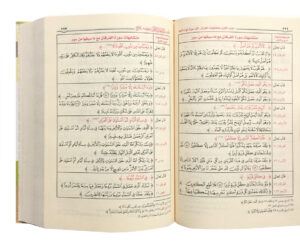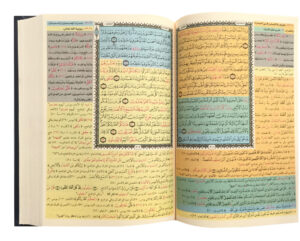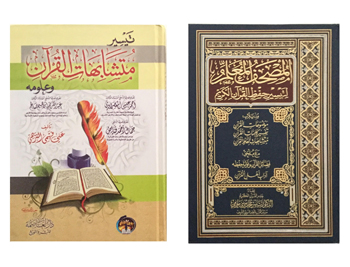al-Āyāt al-Mutashābihāt fī ‘l-Qurʾān is the science of closely worded Quranic verses. Ḥifẓ students are encouraged to familiarise the differences between mutashābihāt verses to better retain their memorisation of the Qurʾān. A variety of mutashābihāt works are available to accommodate different learning styles and progress amounts. Below is a discussion regarding two books from these works.
Title: Taysīr Mutashābihāt al-Qurʾān wa ʿUlūmih
Compiler: ʿAlī Fahmī al-Nazahī
Publisher: Dār al-ʿĀṣimah, Riyadh (2013)
Format: Hardcover
Pages: 912
Contents:
ONE: Mutashābihāt Listed:
- the verses in al-Baqarah that resemble other verses in the same chapter
- from Āl-ʿImrān to an-Nās, the verses in each chapter that resemble verses in chapters preceding
- from Āl-ʿImrān to al-Kahf, the verses that resemble the wording of other verses within that chapter
TWO: Fawāʾid Listed:
- the difference between mutashābihāt lafẓiyyah, i.e. Quranic words that are closely worded (e.g.: التلاق & الطلاق) or assumed synonymous (e.g. القرية & المدينة) or spelled identically but pronounced differently (e.g.: الغَرور & الغُرور)
- the different kinds of Quranic address
- various facts derived from the Qurʾān or about the Qurʾān
- interpretive or terminological or Rasm-relevant exceptions of certain words in the Qurʾān
- which of ten types of speech each Quranic chapter opens with
- different ways Quranic chapters have been grouped
- how to recognize if a chapter is Meccan or Medinan
THREE: Fawāʾid Charted:
- the Meccan or Medinan status of each Quranic chapter (based on majority of its verses) and the verse(s) in each chapter, if any, that contradicts the majority
- the 114 Quranic chapters listed in sequence of divine revelation
- the differences of Kūfī, Baṣarī, Ḥijāzī, and Shāmī scholars on the verse count of each Quranic chapter
- Quranic chapters in order of lowest to highest verse count
- Quranic chapters categorized according to the first letter of their name
- for each chapter, the Arabic letters that only one verse in the chapter opens with (e.g.: in an-Nās the letter ق of قل)
- the number of verses in each of the 114 Quranic chapters that begin with each letter of the Arabic alphabet
- the first verse of each juzʾ
FOUR: Mutashābihāt Charted:
- change of word or letter
- addition of the letterو
- difference of a letter
- the way a mutashābih verse was worded in a precedent chapter versus later in the Qurʾān
- mutashābihāt verses that appear 2 times in the Qurʾān, or those that appear 3 times, or 4, or 5, or 6
Inside:

Title: al-Muṣḥaf al-Muʿallim li Taysīr Ḥifẓ al-Qurʾān al-Karīm
Compiler: Yāsir Muḥammad Mursī Bayyūmiyy
Publisher: N/A
Format: Hardcover
Pages: appx. 650
Contents:
INTRODUCTION: 15 different methods that may be employed to master mutashābihāt verses
MUṢḤAF: There are two parts to every page:
- on the top left, a 15-line 5×7 page reproduced from the Muṣḥaf ʿUthmānī and sectioned by color
- three kinds of annotations bordering the page, color-coded to match the correlating section of verses:
- subject of the verses
- explanation of select words
- verses throughout the Qurʾān that are closely worded with any verse in the correlating section, or particularly the mutashābihāt you would mix it up with. The differences between the verses are highlighted in magenta. Additionally:
- which of the abovementioned 15 methods to employ in this context
- statistics, such as “this slight difference appears in only two resembling verses throughout the Qurʾān, whereas the rest…”
APPENDICES: Two treatises have been included with the book:
- Ādāb Ahl al-Qurʾān, i.e. Etiquette of the People of the Qurʾān
- Faḍāʾil al-Qurʾān wa Nawāyā Ḥifẓih wa Tilāwatih wa Taʿallumih wa Taʿlīmih, i.e. Virtues of the Qurʾān and Intentions of Memorizing, Reciting, Learning, and Teaching it
Inside:

Thoughts:
The relevant aspect is evidently different in both books and from multiple perspectives.
Taysīr lists mutashābihāt verses whereas al-Muṣḥaf al-Muʿallim “teaches” them. The layout in Taysīr is simplistic and clear but the division of information between Section One and Four can prove inconvenient if you choose to utilize both simultaneously. Personally, I think Section One should suffice, especially for those currently memorizing, because the comprehensiveness therein doesn’t compare to that of Section Four, which can be used as a means of assessment instead.
On the other hand, al-Muṣḥaf al-Muʿallim presents all relevant information on the same page— the mutashābihāt verses and the well-researched statistics— but the layout may appear confusing. It is worth mentioning that such statistics can be found in Taysīr as well, in chart form of course, at the end of Section Four, but they are somewhat less comprehensive than those in al-Muṣḥaf al-Muʿallim.
Taysīr lists the mutashābihāt verses within a chapter (for Āl-ʿImrān to al-Kahf), or from preceding chapters (for Āl-ʿImrān to an-Nās), hence only the Ḥāfiẓ or a student memorizing juzʾ 1 onwards can fully benefit. A student who began memorizing from juzʾ 30 backward can partially benefit from the former aspect after memorizing appx. 50% of the Qurʾān and from the latter after completion.
Since al-Muṣḥaf al-Muʿallim indicates towards mutashābihāt verses from the full Qurʾān, progress amount is irrelevant; simply skip over the mutashābihāt mentioned from chapters you haven’t yet memorized.
In regard to learning styles, I would recommend Taysīr to visual and solitary learners; al-Muṣḥaf al-Muʿallim may seem overwhelming with all the words. Logical, interpersonal, and linguistic learners would appreciate al-Muṣḥaf al-Muʿallim.
The mutashābihāt sections in neither book require comprehensive Arabic language skills, particularly because most vital phrases are repeated throughout.
Finally, it should be noted that the purpose here is not comparison. Instead, if students are familiar with the variety of material available on this subject, they can successfully identify which book— or if more than one, which sections— would work better for their learning style and progress amount.
Written by Mariyam H (@attalibah via instagram)






